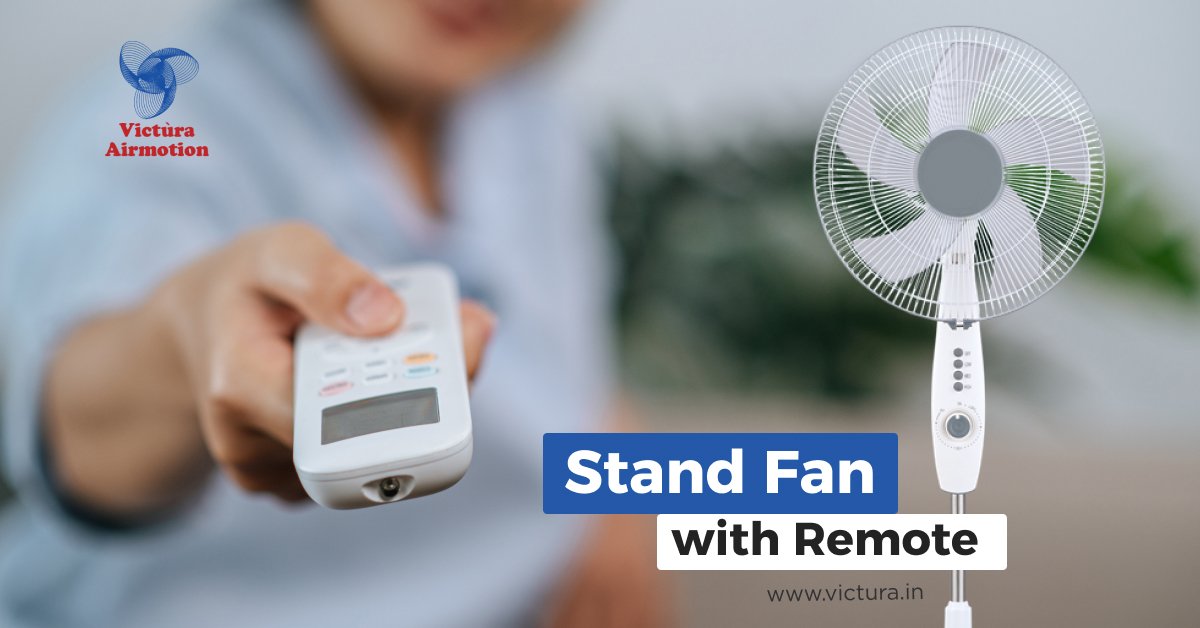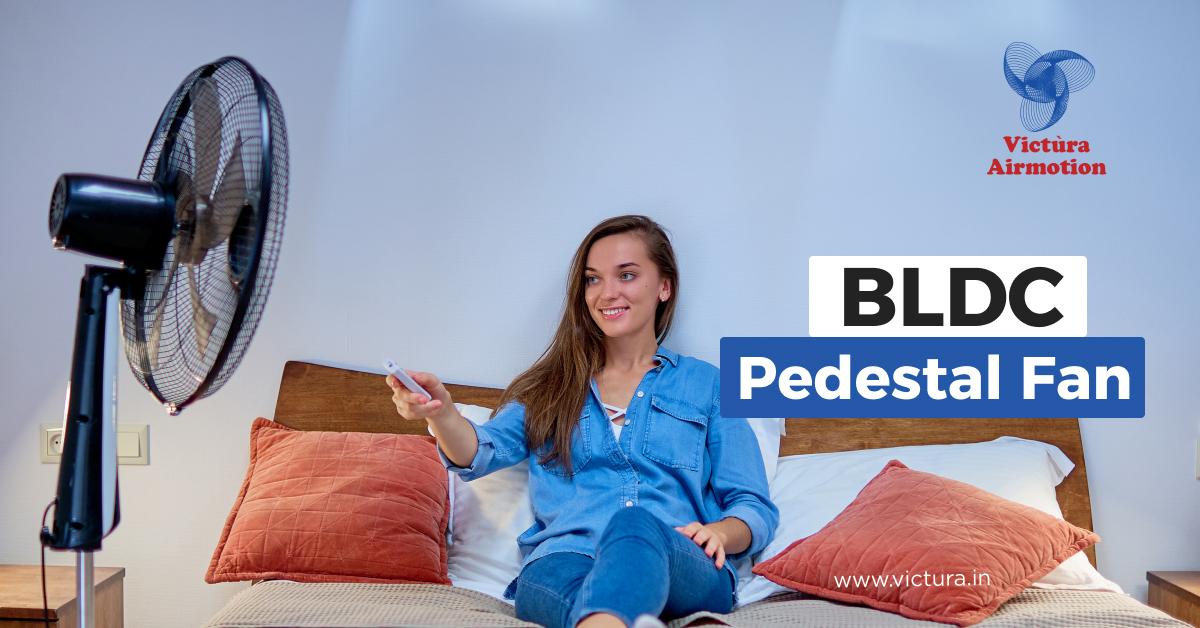What a BLDC pedestal fan can do cannot be undone by a regular fan. Picture this. It’s a hot noon. The sun is harsh, and your living room is like a hot box. You pull in your old standing fan, turn it on, and wait for that warm, light flow of air. Time passes, but you’re still sweaty and uneasy, moving around to find a better wind.
Now think of this. You’re at your friend’s place who got a new BLDC standing fan. It starts quietly, sending a strong, cool wave of air that hits all parts of the room. It feels a lot better, so much that you start to think maybe you need one too.
Difference Between BLDC and Normal Pedestal Fans
Before we explore which one’s better for bigger spaces, let’s understand what makes these fans different.
1. The Motor at the Heart of It
Normal stand fans often run on AC motors. These are old-school and not too costly, yet they come with some catches, like using more power, making more heat, and often being loud when you turn them up.
BLDC pedestal fans use Brushless Direct Current motors. This newer technology eliminates brushes and commutators (parts that traditionally wear out), replacing them with electronic circuits to control rotation.
In easy terms, BLDC fans have smart tech that makes them move better. What does this do? They use less power, create less heat, and are quieter when they run.
2. Energy Efficiency
A normal AC fan could use from 70-90 watts. A BLDC pedestal fan, on the other hand, might do the same (or better) job with just 30-40 watts. That’s more than 50% energy savings right there.
3. Noise Levels
Since BLDC motors run smoother and have fewer rubbing parts, they make much less noise. If you’ve ever had an old fan that shakes loudly when on, you’ll love this change.
What to Look for When Buying a Pedestal Fan
If you are looking at an old type fan or thinking of a BLDC fan, keep these bits in mind:
1. Air Delivery
Shown in cubic meters each minute, this number tells you the amount of air the fan moves. Don’t just look at speed, you want volume. Victùra Airmotion pedestal fans give you high-speed delivery (75 – 110 m3/min).
2. Sweep Size
This is about how big the fan blades are. A bigger size (like 400 mm vs 300 mm) means the fan moves air over a larger space.
3. Speed Control
Multiple speed settings help you adjust airflow as needed. Many BLDC fans also offer smart remote controls or even app connectivity.
4. Build Quality & Stability
For stand fans, a good base is key to stop them from falling over. Look for one that is well-made and does not shake when on high speed.
5. Noise
If you plan to use it where you sleep or work, check how loud the fan is. Many brands now publish noise levels in decibels (dB).
6. Power Consumption
Given rising electricity costs, a fan that runs cooler on your bills makes a lot of sense. Compare wattages before buying.
Pros of BLDC Pedestal Fans for Larger Spaces
So why might a BLDC pedestal fan be a smarter choice if you have a big living room, a spacious hall, or even a covered terrace?
1. Higher, More Consistent Airflow
Thanks to more precise motor control, BLDC pedestal fans often maintain a consistent speed even under voltage fluctuations. That means no sluggish blade rotation when the voltage dips, the airflow stays strong, keeping every part of your room ventilated.
2. Superior Energy Efficiency
Large spaces often need the fan running for hours at a time. That’s where BLDC’s low power consumption shines. Over months of heavy use, the savings on your electricity bill could be substantial.
3. Minimal Noise, Maximum Comfort
In bigger rooms where you might need the fan on full blast, the quieter operation of BLDC technology is a blessing. You won’t have to raise your voice over a droning motor during gatherings or while watching TV.
4. Remote & Smart Features
A stand fan with remote is all the rage these days. In a large space, this means you don’t have to walk across the room just to adjust speed or set a timer.
5. Cooler Running Motor = Longer Life
Because BLDC motors produce less heat, they’re less prone to wear. Especially important if your fan is working overtime in a large area.
6. Often More Stylish
Most BLDC pedestal fans come with modern, slim designs that blend better with contemporary interiors. If your big living room doubles up for entertaining guests, this is a definite plus.

Cons of BLDC Pedestal Fans
No technology is without downsides. Here are a few to consider:
1. Higher Upfront Cost
A BLDC pedestal fan price can be 30-50% more expensive than a comparable AC pedestal fan. For some, this high start cost is a put-off, though many see it save on power money in the long run.
2. Repairs Can Be Tricky
While BLDC fans tend to last, when they fail, they might need hard-to-get parts or skill to fix. A local shop that’s used to fixing simple AC motors might not be equipped to handle a BLDC circuit.
3. Finding Spare Parts
As BLDC stand fans are still getting popular, it could be tough to get spare parts fast if they break.
Conclusion
Let’s circle back to our opening scene. In a big room where you need air to move well, all the time, and softly, a BLDC pedestal fan is the top. It gives strong air movement but doesn’t use much power, keeps its speed even if the power drops a bit, and is very quiet.
But is it the only good pick? Not always. If money is short or you don’t use it much (maybe just for an hour or two each day), a regular pedestal fan will work fine. Yet, for a lot of use in large spaces, the money you save, the comfort, and the trust in a Victùra Airmotion BLDC pedestal fan can make it a better choice.
Frequently Asked Questions
Q1. What is the difference between BLDC and normal pedestal fans?
The main difference is in the motor type. Normal stand fans use old AC motors, but BLDC stand fans use brushless motors that pair with smart tech. This makes them use less power, make less noise, and last longer.
Q2. What is the disadvantage of a pedestal fan?
Stand fans are handy as you can move them, but they can’t cool the air; they just push it around. If it’s really hot, this may not be enough. They use floor space and can fall if they are not strong.
Q3. What are the advantages of BLDC fan over normal fan?
BLDC fans cut power use by up to 50%, are quieter, and keep a steady speed even if the power shifts. They also make less heat, so they wear out slower and usually last longer.
Q4. Is it bad to leave a pedestal fan on all night?
Yes, many people do it to stay cool. Just make sure it’s not going to fall over and it works well. For your health, too much air on you might make your skin or throat dry, so change the direction or set a timer if needed.
Q5. Which is better air cooler or pedestal fan?
It all boils down to your needs. Air coolers cool the air a bit by using water, so they are better in dry places. Stand fans just move air around, but are easy to move and good for just moving air. If it is very moist, a stand fan might feel nicer.
Q6. What to look for when buying a pedestal fan?
Look at the air power (CMM), blade size, speed choices, power use, noise level, and how well it is made. For big rooms or for use for many hours, a BLDC type can save on power costs and is quieter.
See More: How to Install a Fan
